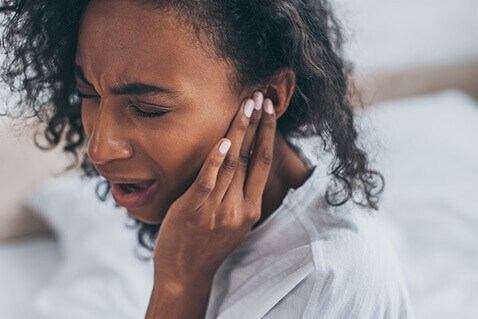

Hearing Loss is a medical condition that can happen suddenly or gradually over time. For best outcomes, it’s important to receive timely medical care from an experienced provider. At Valley ENT we have the latest in diagnostic equipment and the most up-to-date resources to ensure our patients have the best choices in treatment options.
Tinnitus is often described as “ringing in the ears.” It is estimated that as many as 20% of adults are affected by this condition. Some experience ringing while others describe sounds like hissing, clicking or humming. It is a sound that only you can hear, and it can be very frustrating, especially if the sound distracts you and disrupts your ability to concentrate or even hear external sound. The tinnitus may come and go, or it can be present indefinitely.
Tinnitus can be caused by hearing loss, injury, ear infection or certain medications. Sometimes, Tinnitus is caused by other ear problems. The providers at ValleyENT are well trained to know what to look for and are up on all the latest recommendations for Tinnitus treatment. Together, we will create the best plan of action to find symptom relief.
Air pressure balance is important for our ears to hear and function properly. When this balance is thrown off, we can have trouble hearing and/or experience ear pain. Eustachian Tube Dysfunction is when the eustachian tube does not open to allow the correct amount airflow in the middle ear. Some patients describe hearing popping or clicking noises and muffled hearing. Eustachian Tube Dysfunction can be problematic for patients when they travel, experience elevation changes, or even ride in an elevator. A promising new procedure called Eustachian Tube Balloon Dilation is available in our office.
Ear Drum Perforation can happen for a number of reasons and our bodies have an amazing ability to heal themselves. Most of the time small holes in the ear drum will heal on their own. However, about 10% of the time the ear drum needs a little help. If a perforation has not healed naturally within a few months, the provider will recommend a procedure called a Myringoplasty. This can sometimes be done in office to help the healing process along. Dr. Roos will use a very small piece of special paper or a special gel-like material to repair the hole.
It is important to make sure the ear drum perforation heals properly. If a hole is left in the ear drum, there is an increased risk of infection and hearing loss in the future.
If the ear drum perforation is more serious, then a Tympanoplasty will be recommended. This procedure is done in the hospital or surgical center under general anesthesia. Tissue is taken from elsewhere on the body and used to repair the hole. Special packing is used to support the new tissue during healing, and it will dissolve on its own.

When a patient comes to our office with ear pain, there are usually a few things we look for.
At ValleyENT we use a microscope to look directly in the ear to see if there is any blockage in the ear canal, any sign of wax buildup or drainage. Pain can be caused by impacted wax. If we find buildup, we will remove it in office with our specialized instruments and microscope. Often before being seen in our office, patients will try to remove the wax themselves with cotton swabs. We strongly advise against this. Do not insert any foreign objects into your ear canal. When things like cotton swabs are placed in the ear canal you are more likely to push the wax deeper and make the problem worse. You also run the risk of infection or causing permanent damage to the ear drum. We tell all our patients to never put anything into their ears. The best way to clean out wax at home is by using over-the-counter drops made specifically for softening wax so that it drains naturally on its own. For more info on this check out this link: Cerumen Impaction.
Sometimes ear pain can come from an infection of the outer ear. A common infection we see is Swimmer’s Ear. This is when water gets trapped in the ear canal. It can be red and swollen and feel itchy with drainage. If we see signs of this, we usually prescribe antibiotic drops to clear up the infection.
If we look in the ear canal and there are no signs of infection in the outer ear and no wax build up, then we look for pressure behind the ear drum. Sinus infections, colds and even allergies can lead to fluid buildup in the middle ear. This type of infection is called Otitis Media. Sometimes the infection is caused by bacteria and requires an antibiotic. But many times, the source of the problem is not bacterial so the most helpful treatment is an antihistamine, decongestant and/or nasal steroid. The providers at ValleyENT are well versed in Ottits Media care and will know the best course of action to resolve painful ear infections.
Sometimes ear pain is actually not in your ear at all! We know it sounds crazy, but ear pain can happen when you have a tooth cavity, an abscess, sore throat or it can be pain originating from TMJ. The temporomandibular joint (TMJ) is right under your ear. When it is inflamed you can feel pain in your ear. For more information on TMJ check out this link: TMJ